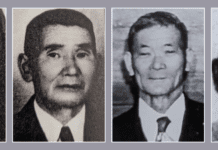
If you take a walk through Jeff Schmiederer’s Mendota-area pistachio orchards, you’ll see trees of various ages and stages. He started planting pistachios in the mid-90s and has continued planting new blocks throughout the years.
The fourth-generation farmer has made some changes to the family land over the years. His maternal great-grandfather started the farm and gave some land to his son, Frank Coit, in the late 1920s. Coit started with about 160 acres and grew that into about 12,000 acres of row crop production, including cotton, tomatoes, melons, grains and more. Farming continued through the generations, and when it was Jeff’s turn, he started introducing permanent crops into the acreage. He said there were a few factors for his decision to make the switch.
“It was labor, and we just weren’t making ends meet with growing tomatoes and cotton. It was tough,” he said. In the end, it was a business decision. The yield wasn’t enough to justify all the costs involved.
“We spent a lot of energy, and we hardly made any money.”

He said at about that time, almonds and pistachios were just starting to take off, and a new pistachio rootstock gave him a chance for a healthier crop. At issue, he said, was that they had been growing cotton, which can leave soils with verticillium, a major problem for pistachios. The new rootstock was resistant to verticillium, which gave growers the ability to plant pistachios in any soil. That, combined with the decrease in labor needs, led Schmiederer to become a pistachio grower.
“In 1995, we planted our first pistachio block,” he said. At the same time, they started planting almonds as well. “Since pistachios take so long to grow, we kind of ‘sprawled in’ more almond acres. Then as the first 80-acre block of pistachios started producing, we planted our next block. It kind of snowballed from there. We kept planting more and more acres of pistachios as we financially became capable.”
Schmiederer said the almond acreage helped him grow the pistachio acreage.
“I always say the almonds planted our pistachios because the almonds came into production quicker. Our return on investment was a lot quicker. It gave us the ability to plant these pistachios, which took a lot longer for return on investment,” he explained. “But now actually, the almonds on our ranch are somewhat fading out and the pistachios are taking over and dominating what we grow out here now.”

He said the pistachios are better suited for the area in which they grow. He cited the lack of surface water, the need to use well water and that pistachios are cheaper to grow.
“They do take less water. They take less fertilizer, less sprays,” he said. “They just take a lot longer to get into production.”
However, he said water does remain an issue, even in pistachios.
“Trees do require a set amount of water each year. You don’t really have a choice.” Schmiederer said row crops allow for some changes depending on water situations. “If you only have this much water, you only plant this many acres. With trees, you’re locked in. Every year, you have to scrounge up the water.”
But, he said, pistachios are a little more forgiving than some other tree nuts.
“If you didn’t have the ideal amount of water, you could get by farming pistachios with half an acre-foot less or a foot less. You’re not going to kill the orchard. Whereas an almond orchard needs its amount of water,” he said. “A pistachio orchard is a lot more forgiving.”

Pistachios also better handle a higher concentration of salt in the water, which is important, he said, because his wells produce saltier water.
“I’ve had almond orchards that I’ve had to put a lot of well water on, and we’ve actually ruined them. We’ve had to pull them out,” he said. In drought years like this, the problem is worse because he must primarily use well water. “But do things to mitigate the problems. We use soil amendments and try to keep salt moving and not staying and stacking in the soil.”
As far as other challenges he’s seen through the years, regulations are top of mind. From the Food Safety Modernization Act to air quality regulations, to the Sustainable Groundwater Management Act, he said the weight of regulations of Californian farmers is bearing down.
“Sometimes you feel like you don’t know what you’re doing wrong out here because you’re not aware of all the new things they’re requiring us to do,” Schmiederer joked. “There’s just all these commonsense things that you would think people already do, but now there has to be safety meetings and training sessions for.”
As for the future, he hopes to keep farming, and he hopes to keep farming at the root of his family by passing it down to his children.
“I’m hoping that we keep farming, that we exist out here,” he said. “The whole idea is how are we going to exist with everything bearing down.”
Schmiederer said that existence relies heavily on water.
“I just hope the state of California can come to some resolution with respect to our water supply and really see the importance of agriculture in our state and start doing something about it,” he said. “Because I would like to see my farming operation continue down the road through the generations.”
















